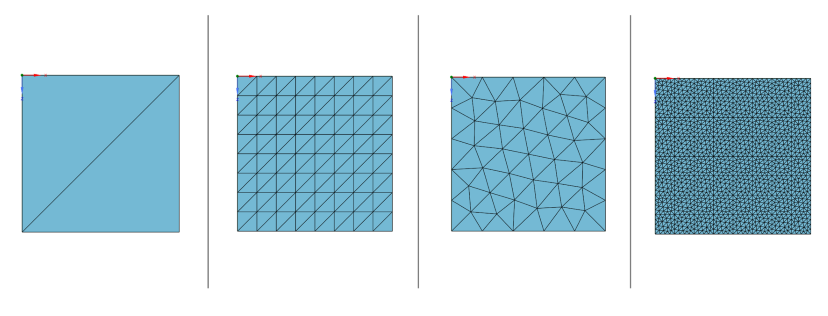Mesh |
In this section, we introduce the meshing processes of
EMA3D® Charge. The air breakdown simulations uses the FDTD mesh, a structured grid of hexahedrals, that is discussed in the EMA3D section of the manual. Here, we discuss the generation of the surface mesh used for surface charging simulations as well as the volumetric mesh used for the FEM and the 3D particle transport source. All meshes generated in the CHARGE ribbon will follow these principles:The dimension of the mesh (surface or volumetric) is set by the type of charging material applied to the geometry and by the domain setting. The user has to be in an internal/coupled domain setting with internal materials set to be able to generate a volumetric mesh. In contrast, the user needs to be in a surface/coupled domain setting with surface material set to be able to generate a surface mesh.
The surfaces of the geometry are discretized by Discovery in the form of structured triangular facets (TR3s), which are then passed to the mesh engine. Discovery facets have their own set of properties to adjust as part of advanced setting options. Their size is defined by the max edge length. The default and minimum amount of facets is a function of the curvature of the surface. However, for a simple square, only two facets will be generated by default.
The mesh resolution setting will be used by the mesh engine to discretize the mesh further into unstructured triangular facets, if the Discovery facets are not already at the desired resolution. The final result is a hybrid mesh of TR3s.
Volume elements are then created only by the mesh engine, based on the final hybrid mesh at the surface. The volumetric mesh that is generated by default is an unstructured mesh of tetrahedrons (TE4s). This mesh is used by the 3D particle transport source to track particles and to calculate particle flux, and by the FEM to keep track of potentials, fields, currents and more.

The generation of TE4s from the surface facets is done by the mesh engine. However, the orientation of the vertices of each facet is a parameter important for the particle transport tool. Hence, when generating a volumetric mesh to use in conjunction with the particle transport tool, the user must enable the orientation checks to ensure that the particle transport tool will work.
One key feature of EMA3D Charge is to be able to define mesh groups for geometries that require finer mesh than what was set in the Global Settings. A subset of surfaces of bodies can be assigned to a mesh group with finer mesh settings to be able to resolve data in thin layers, or thin surfaces, of interest.
As part of the road map of EMA3D Charge, structured volumetric mesh elements will be available very soon. Those structured mesh elements such as HE8s or PR6s, will help improve simulations of thin layers and cables in internal charging problems.
EMA3D - © 2025 EMA, Inc. Unauthorized use, distribution, or duplication is prohibited.